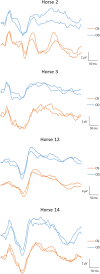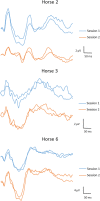Variability, repeatability and test-retest reliability of equine flash visual evoked potentials (FVEPs)
- PMID: 32727477
- PMCID: PMC7389813
- DOI: 10.1186/s12917-020-02463-8
Variability, repeatability and test-retest reliability of equine flash visual evoked potentials (FVEPs)
Abstract
Background: Visual evoked potentials (VEPs) are electrical potentials generated by neurons in the central nervous system in response to visual stimuli. A series of positive and negative wavelets in response to flash-stimuli (flash-VEP; FVEP) or reversing, iso-luminant patterns (pattern-VEP; PVEP) are recorded. Pathological conditions affecting the post-retinal pathways can alter overall waveform morphology, and also affect wavelet peak times and amplitudes. FVEPs have recently been described in horses, but more data on the variability within and between subjects is required, to adequately interpret results from clinical equine patients. Therefore, the purpose of this study was to describe the variability, repeatability and test-retest reliability of equine FVEPs in normal, adult horses.
Results: Equine FVEPs were recorded from one randomly selected eye in 17 horses, from both eyes in eight of these horses, and also at two separate recording sessions in six horses. N1, P2, N2 and P4 wavelets were present in 100% of the recordings in all horses, while P1, N2a, P3 and P5 were only present in some recordings. Coefficients of variation (CVs) were low for P2, N2 and P4 peak times, but higher for all amplitudes. There were no statistically significant differences comparing peak times and amplitudes between eyes or between sessions. Coefficients of repeatability (CRs) are reported for P2, N2 and P4 peak times between eyes (P2; 5 ms, N2; 18 ms, P4; 18 ms) and also between sessions (P2; 5 ms, N2; 16 ms, P4; 39 ms). Intraclass correlation coefficients (ICCs), as an estimate of test-retest reliability, was assessed to be fair to excellent for most parameters.
Conclusions: This study provides important data on variability, repeatability and test-retest reliability of FVEPs in normal, adult horses. We conclude that P2, N2 and P4 peak times should be included in the evaluation of equine FVEPs. The large inherent variability of FVEP amplitudes is likely to make them less suitable and useful for establishing a diagnosis on their own in most clinical patients, but they may occasionally provide support to a clinical diagnosis.
Keywords: FVEP; Horse; Repeatability; Test-retest; VEP; Variability; Vision; Visual evoked potentials.
Conflict of interest statement
The authors declare that they have no competing interests.
Figures




References
-
- Odom JV, Bach M, Brigell M, Holder GE, McCulloch DL, Mizota A, et al. ISCEV standard for clinical visual evoked potentials: (2016 update) Doc Ophthalmol. 2016;133(1):1–9. - PubMed
-
- Sokol S. Visually evoked potentials: theory, techniques and clinical applications. Surv Ophthalmol. 1976;21(1):18–44. - PubMed
-
- Weinstein GW. Clinical aspects of the visually evoked potential. Ophthalmic Surg. 1978;9(1):56–65. - PubMed
-
- Frank Y, Kurtzberg D, Kreuzer JA, Vaughan HG., Jr Flash and pattern-reversal visual evoked potential abnormalities in infants and children with cerebral blindness. Dev Med Child Neurol. 1992;34(4):305–315. - PubMed
-
- Coburn KL, Arruda JE, Estes KM, Amoss RT. Diagnostic utility of visual evoked potential changes in Alzheimer's disease. J Neuropsychiatry Clin Neurosci. 2003;15(2):175–179. - PubMed
MeSH terms
LinkOut - more resources
Full Text Sources
Miscellaneous

